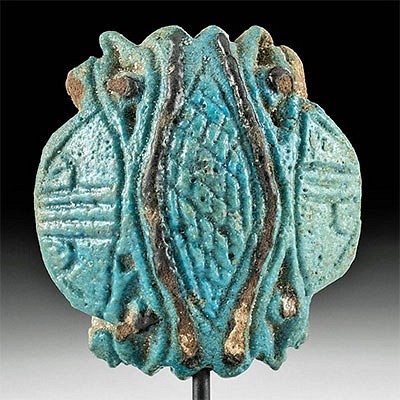Early 20th C. Kwakwaka'wakw Wood Feast Bowl Whales
Lot 283
About Seller
Artemis Fine Arts
686 S Taylor Ave, Ste 106
Louisville, CO 80027
United States
Selling antiquities, ancient and ethnographic art online since 1993, Artemis Gallery specializes in Classical Antiquities (Egyptian, Greek, Roman, Near Eastern), Asian, Pre-Columbian, African / Tribal / Oceanographic art. Our extensive inventory includes pottery, stone, metal, wood, glass and textil...Read more
Categories
Estimate:
$6,000 - $9,000
Absentee vs Live bid
Two ways to bid:
- Leave a max absentee bid and the platform will bid on your behalf up to your maximum bid during the live auction.
- Bid live during the auction and your bids will be submitted real-time to the auctioneer.
Bid Increments
| Price | Bid Increment |
|---|---|
| $0 | $25 |
| $300 | $50 |
| $1,000 | $100 |
| $2,000 | $250 |
| $5,000 | $500 |
| $10,000 | $1,000 |
| $20,000 | $2,500 |
| $50,000 | $5,000 |
| $100,000 | $10,000 |
| $200,000 | $20,000 |
About Auction
By Artemis Fine Arts
May 27, 2021
Set Reminder
2021-05-27 10:00:00
2021-05-27 10:00:00
America/New_York
Bidsquare
Bidsquare : CLEARANCE | Antiquities & Ethnographic Art
https://www.bidsquare.com/auctions/artemis-gallery/clearance-antiquities-ethnographic-art-7010
Featuring discounted pricing and many new items! Asian art, Classical antiquities from Egypt, Greece, Italy, and the Near East...plus Pre-Columbian, Tribal, Russian Icons & Enamelware, Spanish Colonial, Fine Art, more! Some starting prices have been reduced up to 65% from original auction prices! Artemis Fine Arts info@artemisfinearts.com
Featuring discounted pricing and many new items! Asian art, Classical antiquities from Egypt, Greece, Italy, and the Near East...plus Pre-Columbian, Tribal, Russian Icons & Enamelware, Spanish Colonial, Fine Art, more! Some starting prices have been reduced up to 65% from original auction prices! Artemis Fine Arts info@artemisfinearts.com
- Lot Description
**Originally Listed At $5000**
Native American, Pacific Northwest, Kwakwaka'wakw (Kwakiutl) people, ca. early 20th century CE. A hand-carved wooden feast bowl of an enormous size with an ovoid body shaped like a canoe. The flat-bottomed vessel has sloped sides, thick walls, and a deep basin within which different types of foodstuffs would be presented. Illustrated on one side of the vessel are a pair of highly stylized orcas (killer whales) with bifurcated tails, red stripes across the latter half of the bulbous black body, lengthy pectoral fins, streamlined dorsal fins, and a single almond-shaped eye above a gaping mouth. Orca whales are considered to be imbued with potent attributes of strength and power, and merely glimpsing one in the open waters is considered to be a highly symbolic omen. Size: 57.75" L x 9.6" W x 6" H (146.7 cm x 24.4 cm x 15.2 cm)
According to Kwakiutl legend, orcas (also killer whales) were the physical manifestations of the souls of open-water marine hunters who perished or were lost at sea, and this belief is the aquatic parallel to a similar Kwakiutl notion that the souls of forest hunters achieve corporeal materiality as wolves. The Kwakiutl were not of the belief that this was a positive or a negative result of one's soul; however, there were a myriad of symbolically significant rituals that would ensure that the soul of the whale would once again manifest itself in its original anthropomorphic form.
For an example of a Kwakwaka'wakw feast bowl from the 19th century, please see The Metropolitan Museum of Art, accession number 1979.206.932.
Provenance: ex private Ventura County, California, USA collection, acquired prior to 2008
All items legal to buy/sell under U.S. Statute covering cultural patrimony Code 2600, CHAPTER 14, and are guaranteed to be as described or your money back.
A Certificate of Authenticity will accompany all winning bids.
We ship worldwide and handle all shipping in-house for your convenience.
#153803Minor nicks and several stable fissures to base, body, walls, and basin, with light abrasions and fading to original pigment on whales, otherwise intact and excellent. Great remains of original pigment on whales and nice patina throughout.Condition
- Shipping Info
-
All shipping is handled in-house for your convenience. Your invoice from Artemis Gallery will include shipping calculation instructions. If in doubt, please inquire BEFORE bidding for estimated shipping costs for individual items.
-
- Buyer's Premium



 EUR
EUR CAD
CAD AUD
AUD GBP
GBP MXN
MXN HKD
HKD CNY
CNY MYR
MYR SEK
SEK SGD
SGD CHF
CHF THB
THB

















